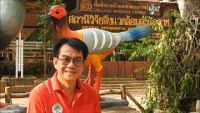Keywords :
Defoliation; Yang Krat (Dipteroearpus Intrieatus Dyer); Daeng(Xylia Kerrii Craib & Hiteh.)
บทคัดย่อ :
Defoliation is an idiosyncrasy of certain tree species. Any deciduous tree, even transplanted from its natural habitat, more or less retains the leaf-shedding habit. It is not far wrong to mention that the defoliation of tropical trees is to reduce the loss of water through transpiration during the hot dry season and at the same time helps to conserve the moisture content in the soil. During the hot dry season the forest floor is parched dry; the stream flow becomes lessening and small waterways are even dried up. The moisture content in the soil plays an important role in the defoliation of tree species,which can be visualized by the rate of the annual defoliation. If there is an unusual, heavy precipitation, trees in the deciduous forests would gradually shed their leaves and send up new leaves at the same time, as the soil still contains its sustained moisture content. Whenever there is drought or less rainfall tree species wold quickly shed their leaves to prevent unnecessary loss of water balance. A comparative demonstration of the cumulative percentage of leaf fall of teng, rang,yang-krat and daeng is shown in Figure 16. It is to be seen that the defoliation of teng and rang were at the peak during November 1968- March 1969, as the rain ended in October and the moisture content of the soil was at its lowest; the defoliation could be clearly seen by leafless trees. An unusual rainfall occurred in the period between November 1969- March 1970, as the last raining day was recorded on 6 November 1969, and thus the moisture content in the soil was greater than usual; the defoliation was somewhat retarded. Through an observation the rate of natural defoliation of teng and rang was comparatively the same as yang-krat. This natural phenomenon is applicable to all deciduous species in the same area.
เอกสารอ้างอิง :
Smitinand, T., Santisuk, T., Nalamphun, A. (1974). The Defoliation of Yang Krat (Dipteroearpus Intrieatus Dyer) and Daeng(Xylia Kerrii Craib & Hiteh.) at ASRCT Sakaerat Experiment Station (Amphoe Pak Thongchai, Changwat Nakhonratchasima). Royal Forestry Department, 1974



